On the odd chance that there are still any gaming enthsuiasts out there who remain unfamiliar with the sometimes contentiously specific “roguelike” premise, suffice to say the term has become a catch-all for games where you grind your way through randomized or semi-randomized dungeons or levels, each time encountering a cyclical variety of threats and rewards drawn from upward-scaling pools, resulting in highly varied and excitingly unpredictable scenarios and character builds. This perpetual tightrope walk between familiarity and novelty can, and often does, offer near-limitless replay value as you strive over and over and over and over to either get farther than you’ve ever gotten before, or to get to the end of a game’s (or game mode’s) predetermined number of levels with a climactic finish.
Pretty much all of this should sound familiar to players of more traditional collectible card games like Magic, where millions have long been acquainted with the intoxicating potential of limitless possibility within a reassuring range of constraints. And while there are plenty of games that apply the roguelike formula to all kinds of overlapping genres — from the fast-paced hack-and-slash / bullet hell / action-RPG genre pastiche of 2020’s universally accoladed Hades, to the methodical, tactical, every-decision-counts turn-based gameplay of old-school titles like the one that gave the genre its name — as you might imagine, this approach meshes extremely well with card-based gameplay.
Over the course of at least the last five years, self-contained “deckbuilder” games — usually digital-first or digital-only card games focused on collecting and upgrading a new, different combination of cards over the course of each play session — have, organically, almost all evolved into roguelikes. This perfect marriage of genres has led to a rapid proliferation of variants on mobile, console, and PC alike.
It also just so happens that five years ago is, you guessed it, when Slay the Spire was released. So an alternative way to look at the game’s widely recognized status as an exemplar of the genre is that it set the template on which most other roguelike deckbuilders have been based — including both its many shining attributes, and its sometimes frustrating flaws.
If you’re an experience-preservation purist like I am, SPOILERS FOLLOW:
Crucial to Slay the Spire‘s longevity and replayability, the four characters — each with its own card pool and base Relic, a constant passive ability — represent genuinely divergent gameplay experiences. The demonic warrior Ironclad racks up massive defense and takes big, high-damage swings; the witchy, rogue-like (ayo) Silent utilizes quick flurries of smaller, low-cost attacks and recurring poison damage; the robot-on-the-fritz Defect employs its own unique mechanic set, “channeling” an assortment of potent passive effects into a variable number of slots; and the Watcher, an iteration on the admittedly problematic “blind seer” trope, switches “stances” on the fly to strategically juggle its energy and damage outputs as well as its vulnerability to damage.
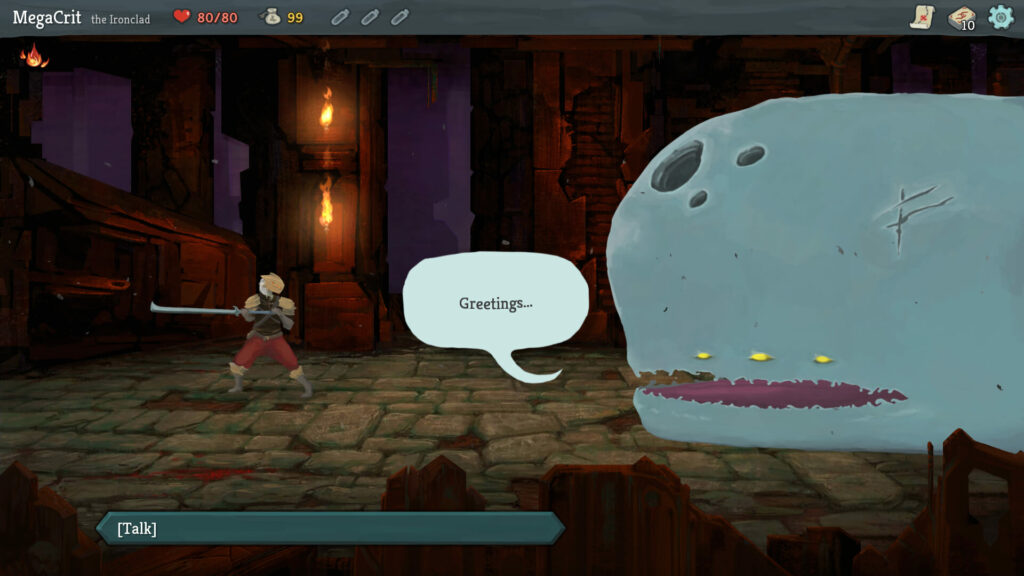
“I am once again asking for your financial support.”
The dungeon’s map system itself is also an integral part of the strategic experience, a simple yet deep feature that isn’t necessarily signaled by the basic pitch of “Battle your way to the top of the Spire!” Based on word of mouth and screenshots, I had originally assumed StS‘s roguelike structure would simply entail going from one semi-random battle directly to another, with opportunities to heal/upgrade/etc at metered intervals between matches — but unlike more minimal deckbuilders I’ve played on mobile, such as Meteorfall: Journey and Night of the Full Moon, here you get to genuinely chart your own course through each level’s semi-randomized map, deciding which encounter types to seek out and which to avoid.
Over the three “Acts” or Spire levels that form the game’s core gameplay loop, you’ll of course gain new cards, find powerful passive Relics, and collect one-shot potions, all usually via battle drops or Shop visits. You’ll also typically want to stop at as many Rest Sites as possible, each one granting you a choice to either heal a percentage of your current max HP, or upgrade a single card to its full potential (usually consisting of either an increased effect or a decreased cost). Other map locations, marked by a question mark, can trigger far-flung special Events of many kinds — some of which are just fun and beneficial, while others are less pleasant or require you to make a tradeoff or tough judgment call.
If you’re the cautious type, you can avoid battles and chase the path of most Rest-instance (sorry); if you love to live life on the edge — or are just feeling especially confident in the build you’ve amassed this run — you can instead steer toward battles to get more Gold, potential potion drops, and chances at optional card rewards (selecting from a random, class-based pool of three by default). Likewise, you can also choose to evade or hunt down the often startlingly powerful Elite enemy encounters that reward you with a random Relic: often very powerful buffs you normally only find once per Act at a predictable mid-level Chest site. Lest you get too clever at dictating your own course, though, the plentiful “?” sites ensure that every run has to involve some unplanned surprises — considering that in any of these spots you may find a battle, a shop, some free bonus, or one of the myriad aforementioned Events.
(One quick aside before I depart from the topic of the maps: while I absolutely love the map system and the ability to choose your path each Act — and while I totally appreciate the classic fantasy iconography of a faux hand-scrawled map style — I do badly wish the location types on the maps were color-coded, as it can be very easy to miss key map details due to their monotonous visual style. For reasons that become apparent once you start clearing Act 3 consistently, it would be a massive boon to tired or disabled gamers even just to mark off Rest Sites’ signature campfire in red, Chests in blue, and the dreaded Super Elites’ spooky glow in green.)
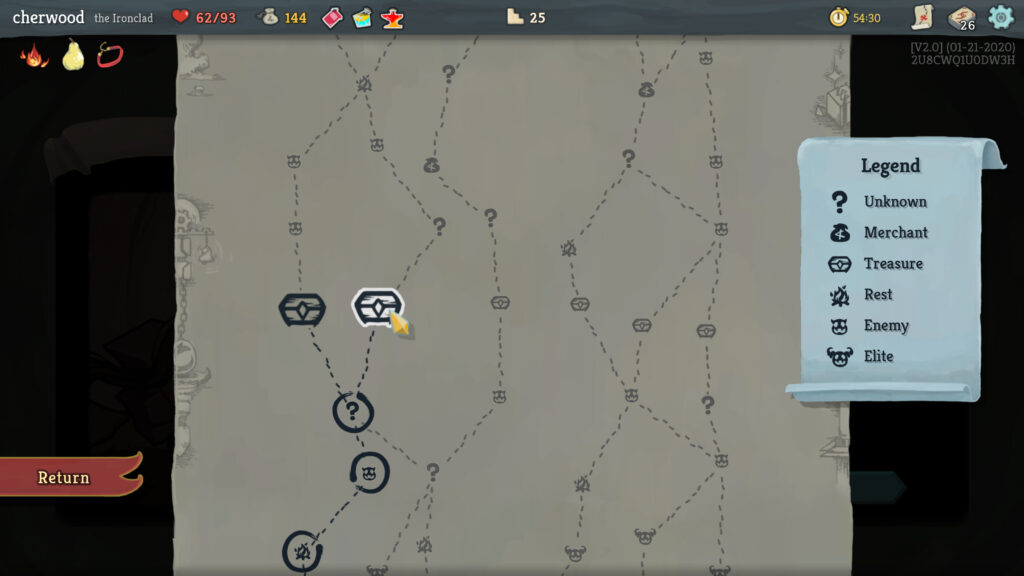
Does the Chest match the Rest?
And although the game can be quite difficult, I’m more impressed than not by the consistency of its learning curve. Even when I was beating my head against a wall trying to clear Act 3 or 4 with the Defect or the Watcher for literally days apiece, I would still be steadily reaching new plateaus of progress — e.g. “At least I’m getting to Act 3 every run!” or “I’ve figured out why I was losing to that boss with the minions!”
Top all of that goodness off with challenging, Act-specific Boss pools and a hidden Act 4 to unlock by juicy, minimally signaled, surprise-laden means — home to two often BRUTAL final battles — and that’s already plenty to sell for $25 and call it a game. Add in zany Daily Climb challenges and Custom Mode’s range of wacky, hyper-granular tweaks — including the Endless Mode that I assumed the whole game would be like, a feature so tucked away in the menus that I sadly didn’t even find out it existed until working on the first draft of this piece — and it’s easy to see why so many players sink 300 hours and beyond into Slay the Spire.
Sadly, the game isn’t free of the problems endemic to this genre — or perhaps, as I alluded to above, this game is what invented some of those problems.
As in most deckbuilders, despite an intrinsic emphasis on randomization and novelty from run to run, some strategies inevitably just end up dwarfing others by miles. As far back as the non-roguelike Ascension (which also exists in IRL box-set form), these games have almost always included some mechanic for deleting cards from your deck to improve consistency. On the one hand, StS is fairly balanced in this regard: it limits the number of predictable opportunities for card deletion to Shop sites that charge a non-nominal, steadily increasing fee in Gold; and developer Mega Crit Games also introduced new post-release late-game content (including the entirety of Act 4) featuring enemy strategies that actively punish excessively small decks. On the other hand — and surprising absolutely zero competitive CCG players — the vast majority of the time, thinning out your deck to its strongest core components, AKA “slimdecking,” unfortunately still reigns.
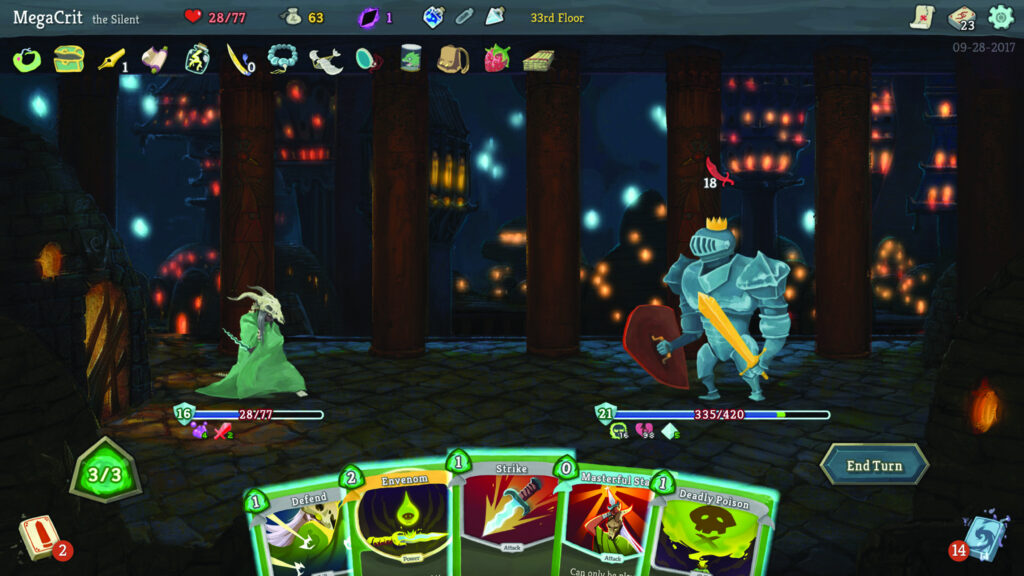
“Okay, you know what, maybe we can talk this out…”
In another modest issue common to deckbuilders, the character classes are…a little unbalanced:
The Silent struck me as by far the “best” class early on, quickly racking up poison to deal significant damage turn after turn with high card- and energy-efficiency. If you just want breeze through the three main Acts for a quick taste of the game, this is definitely the character for you — but for better and worse, no matter how well I learned the other characters, the Silent always remained my fastest, easiest avenue to a nice, satisfying Act 3 or Act 4 clear.
As you develop more playskill, the initially tricky Defect turns out to have a wealth of different combos to exploit, hidden in its complex card pool and highly original unique mechanics. I really have to commend Mega Crit specifically for the ingenuity in this class’s design, which feels truly new and fresh compared to every other playstyle I’ve seen in deckbuilders. It’s kind of like a little minigame of its own — almost to a fault where, on runs in which you unlock the enticing ability to mix classes’ card pools, many Defect cards are literally useless if you’re playing a different character.
Within each class, as well, there always seems to be a best deck or build you’ll start to actively gun for.
For me, the Ironclad has seemed at its most powerful with a deck based around racking up astronomical block numbers, retaining them turn after turn, and then converting them to damage — and if you get very, very lucky, you can try to build an infinite-damage/infinite-block deck that still works when slimmed to as few as four cards.
The Silent too has at least one infinite combo, and it’s even slightly easier to slimdeck toward due to the game’s built-in card rarities — but I’ve never bothered to try, as the character’s poison mechanic already delivers top-shelf damage and leaves ample deck space for defensive coverage plus whatever interesting bits of spice you come across.
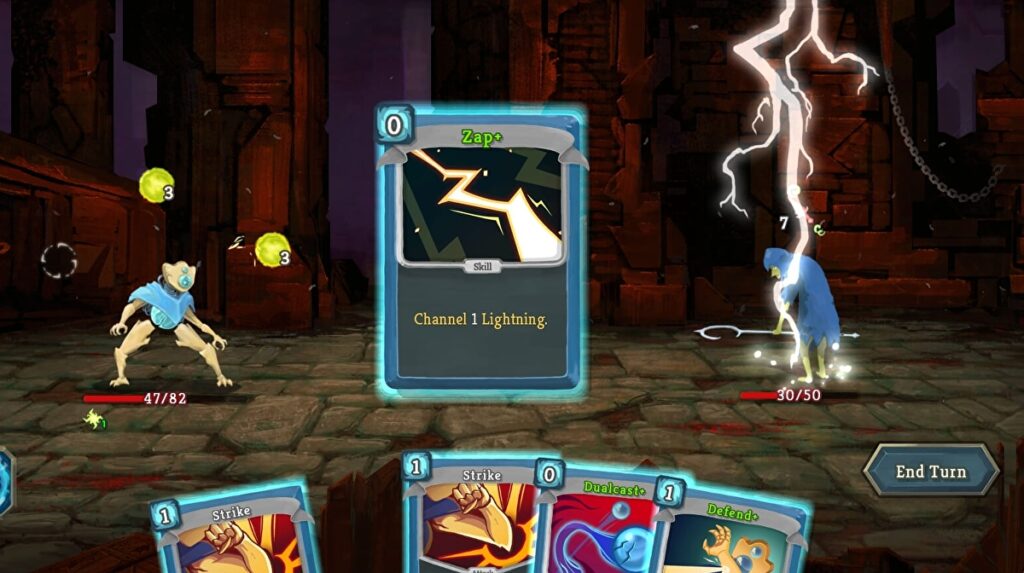
The Defect is “on the fritz.” Get it?
The Defect may have the most diverse range of high-powered options once you get familiar with its card pool and playstyle, though I’ve had my best results with decks built around a glut of static Power cards, especially those that trigger off of playing more Powers — think of this as like Enchantress’s Presence-style decks in Magic — and one personal favorite that triggers Lightning damage in response every time you take a hit. Because many enemy attacks (especially among Bosses and Elites) hit multiple times in a turn, this becomes fierce and can often kill an enemy before their current attack string is finished, sparing you further damage — especially when paired with another Power that makes your Lightning hit all enemies, rather than a randomly selected one, like a “Lightning-All” materia triggered by every unblocked hit of every incoming attack.
I find the Watcher, the only character introduced in post-release content updates, an extremely fun and very mentally engaged playstyle — and, accordingly, the hardest to master. Switching frequently between the high-risk, high-reward Wrath pose, which doubles both your damage dealt and damage received, and the more defensive, multi-turn-energy-setup Calm pose, really calls for your full attention. It can also build to the explosive, triple-damage, one-turn Divinity stance — and has access to a whole alternate damage path by way of a poison-like Common card called Pressure Points (technically a Skill and thus exempt from any penalties imposed on Attacks) which, each time it’s cast, repeats its previous damage to all enemies.
The Watcher is also fucking impossible to win with?
This is where I have to address the game’s biggest problem: while I do sincerely love a good challenge in my games — I’m even occasionally the kind of sicko who goes and S-Ranks all of Cuphead — far too much of Slay the Spire‘s “difficulty” arises from variance alone. Of course, I realize that variance is always going to be an element in a deck-based game — and in a roguelike deckbuilder, it’s even kind of literally the point — but it should never be the key barrier to overall progress for even a relatively seasoned player.
I think it’s perfectly reasonable to expect that if a player of relevant gaming experience and moderate playskill invests a significant amount of time into learning a game’s nuances, matters of pure, unpredictable variance (or, for that matter, opaque signaling) should no longer bottleneck them with any consistency — yet at no point in my StS journey have the game’s least predictable elements stopped thwarting even some of my most high-powered, “on fire” Spire runs. As a result of these variance issues, paired with the relatively imbalanced classes, a player who’s determined to try to clear Act 4 with every class can easily end up having to spend more time playing the classes that feel less rewarding.
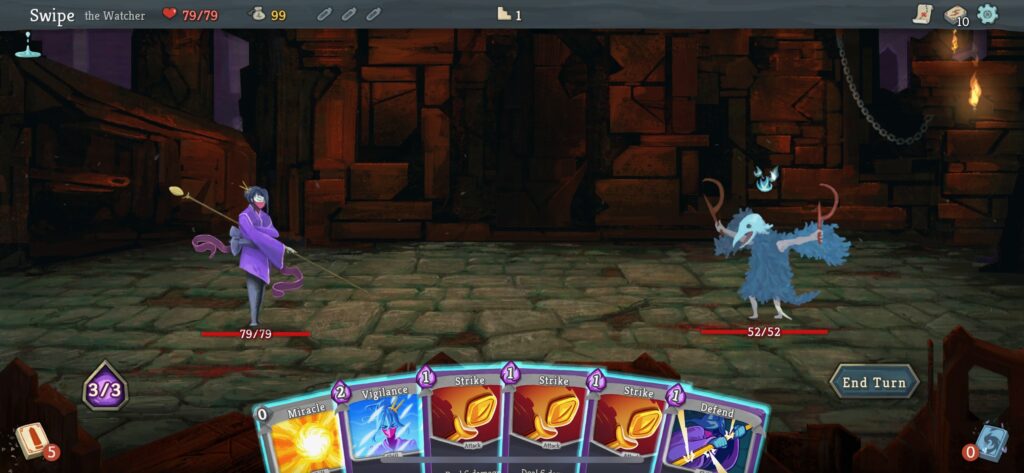
I always feel like…somebody’s watching me…
For one example, I’ve hardly played the Silent at all relative to how much time I’ve had to spend learning the Watcher or trying to go Ironclad-infinite. To be specific, after over 101 hours of gameplay — fully over 40% of which I’ve spent as the Watcher, as the Character Stats screen helpfully tells me — I still can’t beat Act 4 with the damn thing. I ended up at a plateau where I would reach the final-final boss more often than I didn’t — but any joy I might have derived from such a challenge was long since drained from the experience, and I already felt thoroughly burned out on the game by the time I reached that plateau.
It’s one thing to hit a ceiling where you keep losing because of a skill you’ve yet to master or a lesson you’ve failed to learn, as is common in Souls-like gameplay and other reflex-heavy, action-focused genres. But it’s another thing altogether when it happens because a boss can suddenly deal “6×12” damage at any time and you didn’t draw exactly Spirit Shield that turn — after weeks of practice and tinkering with a tight, robust defensive build basically geared toward surviving exactly that attack.
With all of that said, I’m sure that I do still have lessons to learn. Only in my last few runs did I find the potent ≈slimdeck recursion engine of Meditate+ getting back Spirit Shield+ and Eruption+, allowing me to re-trigger Calm energy each turn, deal 2-3 high-damage attacks in Wrath, and still end up back in Calm at the end of the turn with a substantial block stack (bolstered, of course, by Mental Fortress+). I also heard it suggested by one friend and confirmed by another that a key component to defeating Act 4’s Big Bad with the Watcher is the card Vault, a relatively high-cost Skill whose base form, translated into Magic lingo, says “End the turn, then take an extra turn” and exiles itself.
The problem is, I’m so frustrated and burnt out that I no longer want to keep trying — as I’ve simply died far too many times, in far too many downright infuriating endgame scenarios where I was fairly confident I’d done everything right given the options available. When a player can sincerely work for a long-ass time to absorb the lessons of a self-contained, technically finite game like Slay the Spire and still lose consistently to sudden, unpredictable match swings — even ones that, at best, are trying to teach you to start over and practice a different strategy for another 20 hours — that’s just plain feel-bad design.
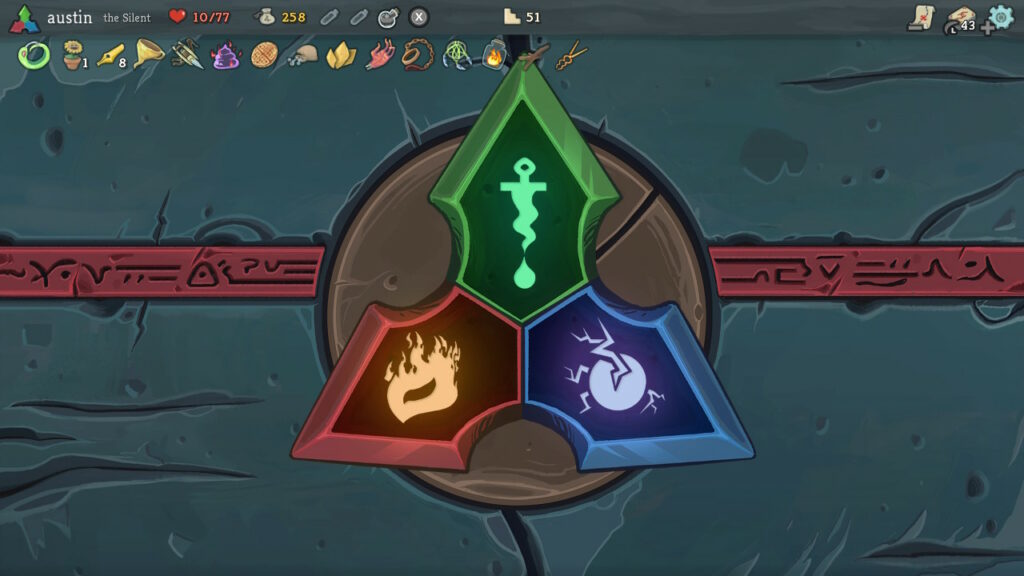
Congrats on 100 hours! Tutorial: complete.
I still have a ways to go in my exploration of the blossoming roguelike/deckbuilder genre, given how it’s exploded in popularity over the last couple of years — as the heyday of the Souls-like / roguelike / Metroidvania pick-any-two-buzzwords genre seems to finally, thankfully start to wane (no matter what Elden Ring has to say about it). Since calling it quits on Slay the Spire, I’ve been enjoying the hell out of a more unconventional entry in the genre, solo dev Terry Cavanagh’s ambitious and joyful Dicey Dungeons, and I still have yet to try some other acclaimed titles like Griftlands, Monster Train, Meteorfall: Krumit’s Tale, or Inscryption. I hope to cover these here on Hipsters in future posts, furthering my understanding of the ways in which Slay the Spire fulfills, bucks, or sets the genre’s trends — a much more affordable interpretation of the phrase “collectible card games” when compared to my checkered history as a recovering Magic addict (that’s not a joke) and on-again/off-again singles vendor.
In the meantime, don’t get me wrong based on how much of this piece has been devoted to ways I’d like to see the game and its descendants improve in the future: Slay the Spire is an amazing experience full of original ideas, best-in-class execution on existing trends, and the potential to bring any diehard lover of card-based gameplay hundreds and hundreds of hours of enjoyment and discovery. There is no question that of all the many entries I’ve seen in this young, budding genre, StS is the one that comes closest to feeling like some secret, twenty-years-running CCG you managed not to hear about until it was already at the stage of maturity, rich with hidden corridors and complex interactions to unravel. Digging deep into it has actually, in its own way, brought me back to the early days of Magic — when there was something new and unexpected on every card, and one felt as if they might just yet discover something no one else had found before.
Indeed, there’s little doubt in my mind that Slay the Spire absolutely deserves its status as the exemplar of its genre — warts and all.
SINISTRA BLACK is an LA-based writer-director, Transgender Anarchist killjoy, and Silent, Ironclad Defect Watcher.
She publishes other writing and a weekly newsletter on her homepage, EASY ANSWERS. She can also be found on Twitter, Facebook, and other platforms, sharing humor, criticism, scorching takes, and extra turns.
She is available for hire or deckbuilding advice, as long as you stopped following Magic in 2018.
For more…critical…criticism, check out Jessica Jones Season 1 Is Way More Racist Than You Remember and other Marvel reviews linked therein. If podcasts are more your thing, try DEAD EYES: On Hating the Nicest Guy in the World. If neither, idk standup comedy i guess? jesus
If you enjoyed or valued this free post from Hipsters, slay, queen. Also, please share, send it to a friend, and subscribe to EASY ANSWERS for more content from Sin.

